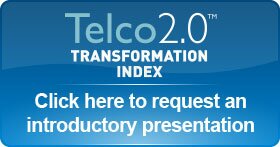This 145-page PowerPoint style PDF report (and accompanying Excel data pack) examines the transformation efforts of Verizon Communications as it both embraces a Telco 2.0 Happy Piper philosophy and begins to explore new Telco 2.0 services more generally. Verizon’s positioning in the large US market, and how this is changing within its individual operating segments, is analysed and supplemented by a broader discussion of the US economy’s growth prospects and digital maturity.
The report also examines Verizon’s service offerings in detail by describing and evaluating both its core services and its early efforts in cloud, healthcare and M2M. Partnerships Verizon has entered with CSPs (e.g. ISIS) and those outside the industry (e.g. Redbox Instant) are covered in the Value Network section.
The report covers a general discussion of the challenges and importance of technology transformation is followed by a dive into Verizon’s financial results and revenue model, and how these will look different after the VZW deal closes.
The report highlights key strengths (e.g. differentiated network) and weaknesses (e.g. VZW debt-burden) are highlighted and strategic priorities are provided in the light in the light of these.
Who is it for?
The Telco 2.0 Transformation Index is the world’s first benchmark of Communications Service Providers provides benchmarking and deep analysis, the index reports are designed for:
Telcos and CSP operators (including those covered, those operating in the same markets and telcos operating in other markets)
For vendors either partnering with or wishing to partner with these telcos
Investors seeking to understand where to place their bets with CSPs
Determine the key drivers of telecoms industry transformation
Clarify Verizon’s performance in specific areas of transformation
Understand Verizon’s relative strengths and weaknesses
Learn from Verizon’s transformation activities
Prioritise transformation projects at your organisation
Determine how your solutions can support Verizon
Improve your value propositions for Verizon
There’s more on the benefits and packages here
Format and pricing
|
|
|
|
|
Contact us for pricing on +44 (0)207 247 5003 or [email protected]

Background: Defining Telco 2.0
The declining Telco 1.0 business model
The role of Telco 2.0 in bridging the digital ‘hunger gap’
Key Telco 2.0 skills, relationships, operational and financial models
The financial benefits of shifting from Telco 1.0 (Infrastructure business) to Telco 2.0 (Infrastructure + Platform and/or Product Innovation)
Telco 2.0 Transformation Index Overview
Methodology
Data sources
Executive summary
Figure 1: Example output - Verizon - Marketplace section

Figure 2: Example output - Verizon - Service Offerings section

Summary findings
6 service offering categories defined:
Core services
Vertical industry solutions
Infrastructure services
Embedded communications (including M2M)
Third-Party business enablers (including identity, marketing, advertising, payments)
OTT services
Telco 2.0 services strategies defined – ‘Happy Piper’ and ‘Service Provider’
Verizon’s Telco 2.0 services strategy
Summary performance by service offering category
Evaluation of specific services within each service category
Figure 3: Example output - Verizon - Value Network section

|
Execution:
|
|||||||
Figure 4: Example output - Verizon - Technology section


Summary findings
Financial performance: profitability, return on investment, debt position, capital intensity
Finance and Telco 2.0 strategy alignment: use of Telco 2.0 metrics
Revenue Model: ability to protect Telco 1.0 revenues and grow Telco 2.0 revenues
Cost Model: Capital investment and operating cost levels including revenue per employee
|
|
Contact us on +44 (0)207 247 5003 or email for further details.
Return to the Telco 2.0 Transformation Index home page, or see more on the Benchmarking Report, Telefonica, Vodafone, AT&T, Verizon, Singtel and Ooredoo deep-dive reports.
4G LTE, 4G Venture Forum, ADSL, AWS, broadband, carrier Ethernet, CDN, cloud computing, CloudSwitch, customer churn, digital advertising, digital commerce, digital services, DOCSIS, eHealth, enterprise services, FCC, FiOS, FTTH, GPON, HealthSpot, Hughes Telematics, IAAS, identity, In-Drive, Innovation Centers, Invidi, IP conferencing, IPTV, ISIS, LTE, M2M, managed hosting, managed services, messaging, mobile advertising, mobile payments, Networkfleet, new business models, OC-48, OTT, payments, PAAS, PoC, post-pay, pre-pay, Quest Diagnostics, Redbox Instant, SAAS, Share Everything, SIP trunking, SMBs, SMS, SONET, strategic services, SureScripts, Telco 2.0, TV Everywhere, Ubuntu, U-verse, VDSL, Verizon Digital Media Services, Verizon Enterprise Solutions, Verizon Foundation, Verizon Precision Market Insights, Verizon Terremark, Verizon Universal Identity Service, Verizon Wireless, voice, VoIP.